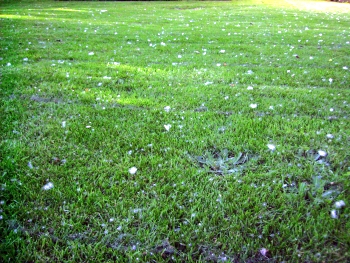
Publisher:
Bonnie King
CONTACT:
Newsroom@Salem-news.com
Advertising:
Adsales@Salem-news.com

~Truth~
~Justice~
~Peace~
TJP
May-08-2007 16:30

 TweetFollow @OregonNews
TweetFollow @OregonNews
Pollen Returns to Oregon Like Wintertime Snow
Salem-News.comAn estimated 35 million-plus people in the U.S. suffer from seasonal allergies.
 Pollen sticks to a backyard home in south Salem Monday night like wintertime snow. Photo: Kevin Hays |
(SALEM) - Good News! The sun and warmer temperatures have returned to Oregon.
The Bad News! Brisk winds through the mid-Willamette Valley over the past few days has allergy suffers seeing red.
During the day, pollen is spreading throughout the valley like blowing snow, and at night is sticking to roadways and lawns.
Roger Emert, an allergy specialist at the New York Presbyterian Weill Cornell Medical Center, recently shared his tips for combating watery eyes and the sniffles on ABC's Good Morning America:
Start taking prescription medicines earlier. If you've been tested for allergies and know you're allergic to pollen, consider taking your medication earlier than usual. They're more effective if you start taking them before symptoms appear.
Try non-sedating antihistamines. Claritin is the most popular non-sedating antihistamine.
Keep windows closed. It's especially important to keep windows closed on windy days and in the morning, when pollen counts are highest. If you'd still like to get fresh air into your home, consider a Safeguard Window Filter.
Turn on the air conditioner. This will help filter the air. Air purifiers are made to remove allergens and toxins from the air in your home, and dehumidifiers are important allergy relief appliances for hot, humid environments.
The following tips are from the American Academy of Pediatrics.
WHEN TO SUSPECT AN ALLERGY
Some allergies are easy to identify by the pattern of symptoms that invariably follows exposure to a particular substance. But others are more subtle, and may masquerade as other conditions. Here are some common clues that could lead you to suspect your child may have an allergy.
Recurrent red, itchy, dry, sometime scaly rashes in the creases of the skin, wrists, and ankles.
Repeated or chronic coldlike symptoms - that last more than a week or two, or develop at about the same time every year. These could include a runny nose, nasal stuffiness, sneezing and throat clearing.
Nose rubbing, sniffling, snorting, sneezing and itchy, runny eyes.
Itching or tingling sensations in the mouth and throat. Itchiness is not usually a complaint with a cold, but it is the hallmark of an allergy problem.
Coughing, wheezing, difficulty breathing, and other respiratory symptoms. Coughing may be an isolated symptom; increases at night or with exercise are suspicious for asthma.
COMMON ALLERGENS ON THE HOME FRONT
- Dust (contains dust mites and finely ground particles from other allergens such as pollen, mold and animal dander)
- Pollen (trees, grasses, weeds)
- Fungi (including molds too small to be seen with the naked eye)
- Furry animals (cats, dogs, guinea pigs, gerbils, rabbits, and other pets)
- Latex (household articles such as rubber gloves and toys, balloons
- Foods such as cow's milk, eggs, peanuts, tree nuts, soy, wheat and fish
HOW TO MANAGE ALLERGIC NASAL SYMPTOMS
Many children are allergic to pollen and mold, both of which are found everywhere outdoors and cannot be completely avoided.
It's helpful to use air conditioners, where possible, to reduce exposure to pollen in both your home and your car. Molds are present in the spring and late summer, particularly around areas of decaying vegetation. Children with allergies to molds should avoid playing in piles of dead leaves in the fall.
Dust mites congregate where food for them (human skin scales) is plentiful. They are especially numerous in upholstered furniture, bedding and rugs.
Padded furnishings such as mattresses, box springs, pillows and cushions should be encased in allergen-proof, zip-up covers, which are available through catalogs and specialized retailers.
Wash linens weekly, and other bedding such as blankets, every 2 to 3 weeks in hot water. Pillows should be replaced every 2 to 3 years.
MEDICATIONS TO SUPRESS SYMPTOMS
Your child's allergy treatment should start with your pediatrician, who may refer you to a pediatric allergy specialist for additional evaluations and treatments.
Antihistamines - Help with itchy watery eyes, runny nose and sneezing, as well as itchy skin and hives. They may cause drowsiness.
Decongestants - Help with stuffy nose.
Nasal Corticosteroids - Highly effective for allergy treatment and are widely used to stop chronic symptoms. Safe to use in children over long periods of time.
Allergy Immunotherapy - Immunotherapy, or allergy shots, may be recommended to reduce your child's sensitivity to airborne allergens. Not every allergy problem can or needs to be treated with allergy shots, but treatment of respiratory allergies to pollen, dust mites, and outdoor molds is often successful.
COMMON TRIGGERS OF ASTHMA
- Allergies
- Molds
- Pollen
- Dust
- Mites
- Cockroaches
- Animals (especially cats and dogs)
- TOBACCO SMOKE
- INFECTIONS
- Viral respiratory infections, including colds
- Sinus Infections
- OUTDOOR AIR POLLUTION
- INDOOR AIR POLLUTION
- Aerosol sprays
- Cooking Fumes
- Odors
- Smoke (wood fires, wood-burning stoves)
- EXERCISE
Articles for May 7, 2007 | Articles for May 8, 2007 | Articles for May 9, 2007
Quick Links
DINING
Willamette UniversityGoudy Commons Cafe
Dine on the Queen
Willamette Queen Sternwheeler
MUST SEE SALEM
Oregon Capitol ToursCapitol History Gateway
Willamette River Ride
Willamette Queen Sternwheeler
Historic Home Tours:
Deepwood Museum
The Bush House
Gaiety Hollow Garden
AUCTIONS - APPRAISALS
Auction Masters & AppraisalsCONSTRUCTION SERVICES
Roofing and ContractingSheridan, Ore.
ONLINE SHOPPING
Special Occasion DressesAdvertise with Salem-News
Contact:AdSales@Salem-News.com

googlec507860f6901db00.html



Terms of Service | Privacy Policy
All comments and messages are approved by people and self promotional links or unacceptable comments are denied.
[Return to Top]
©2025 Salem-News.com. All opinions expressed in this article are those of the author and do not necessarily reflect those of Salem-News.com.